Every time I travel to château d’Ecouen, a 50 mn drive through St Denis and Sarcelles, I have the same emotion in anticipation of all the beauties this Museum of Renaissance conceals. This time, the new exhibition called “Le Blason des Temps Nouveaux” (The coat of arms of Modern Times) is even more mysterious than previous ones. And it needed all the charm and erudition of the curators to keep our attention on the details of medieval heraldic. Ecouen which was owned by Anne de Montmorency is full of these signs sculpted or painted on fireplaces, walls and stained glass windows. For the first time I realized that coats of arms were like a painter’s signature at the bottom of a frame… The chapel is the first step to the show, with the copy of Leonardo’s “Last supper” by Marco d’Oggiono, which was commissioned in 1506 by Gabriel Gouffier, whose coat of arms figures on the bottom.
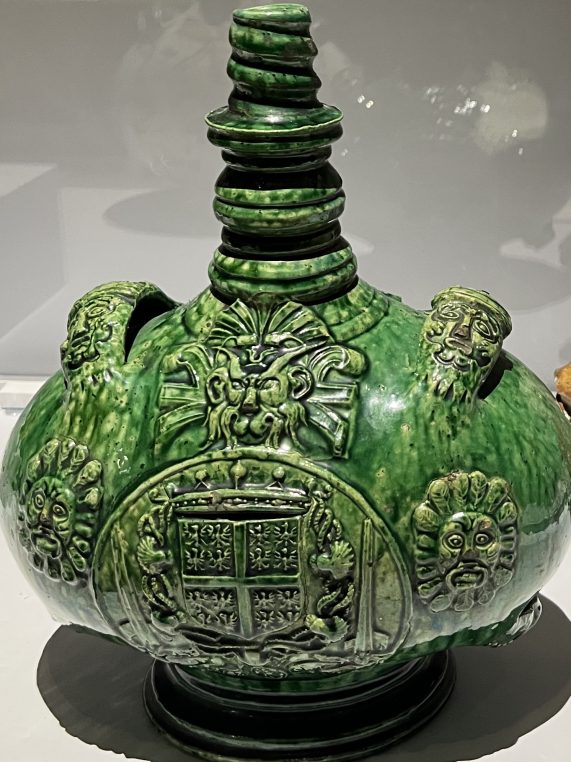
Enameled Pilgrim’s Water bottle with Anne de Montmorency’s coat of arms, Saintonge? after 1551, Paris Musée du Louvre
A beautiful tapestry representing the allegory of love, made before 1531, carries a crowned heart on the border. This is the signature of Gui de Baudreuil, abbey of Saint Martin aux Bois in l’Oise. What a strange thing to have an abbot characterized by a heart!
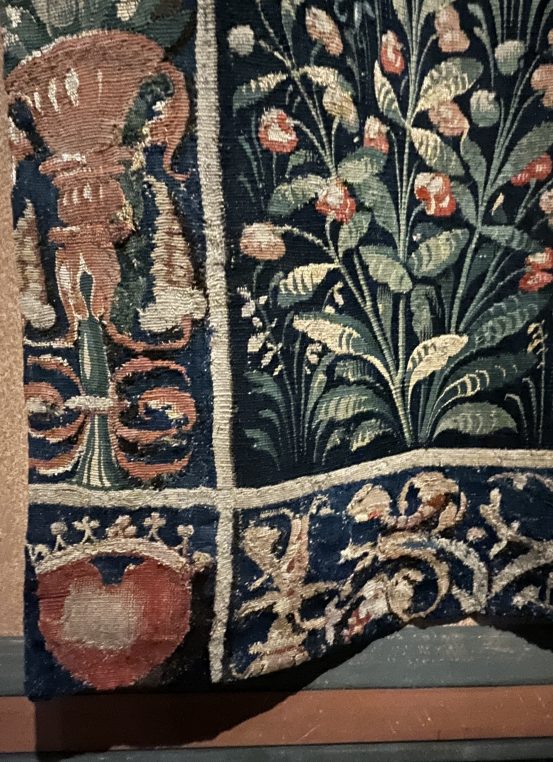
The crowned heart on the border of the tapestry ” Allegory of profane love” is a sign that Gui de Baudreuil commissioned it for Abbaye de Saint Martin aux bois
Another large tapestry with the battle of Saint Denis made at the end of the XVI th century shows the coat of arms of Michel d’Astarac, baron de Frontrailles and his wife. One can see the flags of protestants and catholics on the battlefield.

Coat of arms of Michel d’Astrarac in the tapestry of the battle of St Denis, which belongs to Ecouen
Laurent Hablot who succeeded Michel Pastoureau at Ecole Pratique des Hautes Etudes is co-curator of the show with Thierry Crépin-Leblond, director of Eocuen and Anne Ritz-Guilbert from l’Ecole du Louvre. They described with passion the 100 objects which use heraldic on multiple mediums from illuminated books to sculptures, paintings and tapestries. Much of today’s knowledge comes from a collector and historian, François -Roger de Gaignières (1642-1715) who roamed the North of France and copied all emblems from the nobility and the monarchy, thus creating a rich “database” (7 500 drawings) on heraldic.
On the way up to Catherine de Medici’s apartments, one notices the staircase with sculpted vaults carrying Madeleine de Savoie and Anne de Montmorency’s arms. An armor which belonged to François de Montmorency, the bed of the Dukes of Lorraine, the pavement of the apartments commissioned in 1542 to Masséot Abaquesne, all lead to a massive fireplace and stained glass windows on the upper floor.
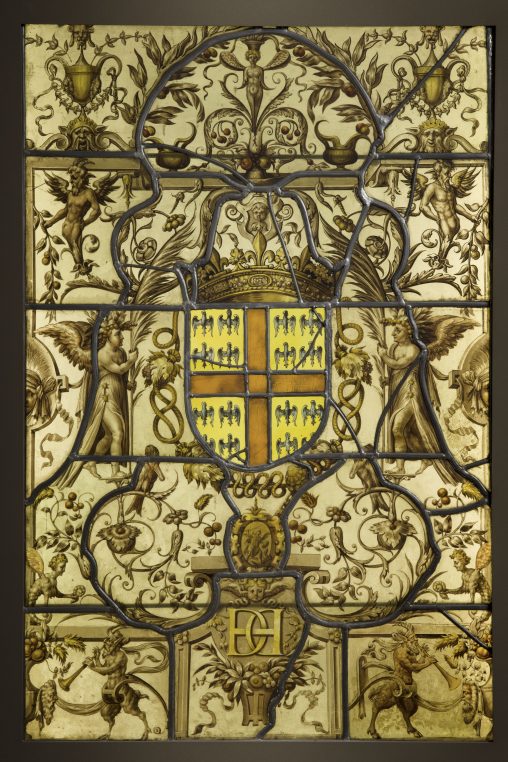
Coat of arm of Anne de Montmorency on the stained glass window, after 1547, ©Musée du Louvre, Dist. RMN-Grand Palais, Philippe Fuzeau
In his introduction to the catalog, Michel Pastoureau mentions the extraordinary effervescence of emblems which contribute to the esthaetisation of social connections. From the Middle Ages to the renaissance, there is continuous creativity in terms of coats of arms ad emblems. Anyone can create his own as long as he does not borrow from others. 3 to 5% of the French population uses these signs, the nobility, the clergy and patricians. These arms have three functions: they establish the identity, they prove ownership and are ornemental like on servants’ liveries. They prosper in churches, on tombs, walls, ecclesiastical clothes and books.
A wedding basket in faience carries a polychrome coat of arm of Jacques Nouhes and Anne de Mornay, both children of Henri IV th companions. The importance of the wife’s coat of arm is interesting because very often when the lady’s family wa s’more important that the husband’s, her arms were prominently displayed. Francis 1 er ‘s bronze stirrups are displayedwith their crowned salamanders, Elisabeth de Valois’s violin made in Cremone, a precious key with Charles IX’ devise, a wooden door with Claude d’Urfé’s chiffre.

A wedding basket in faience, Nevers 1603 ©RMN-Grand Palais (musée de la Renaissance, château d’Ecouen) Mathieu Rabeau
The exhibition is a good reason to return to Ecouen and roam the multiple rooms and salons. I tis fun to search for teh emblems and coats of arms in the tapestries and furniture. Until February 6, Château d’Ecouen.
Share this Post
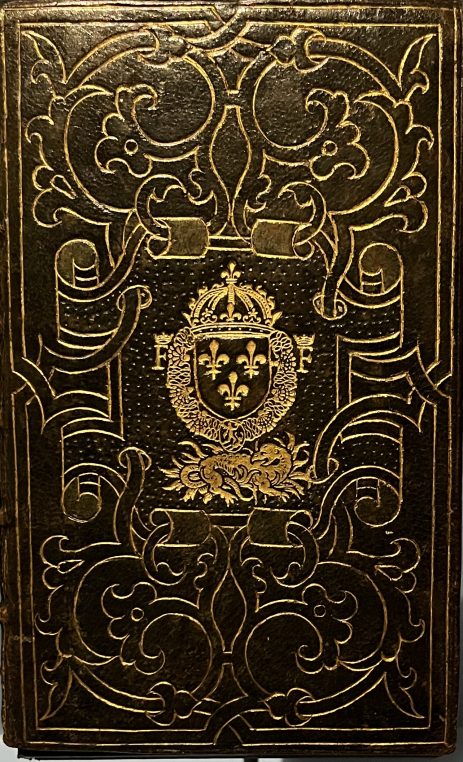

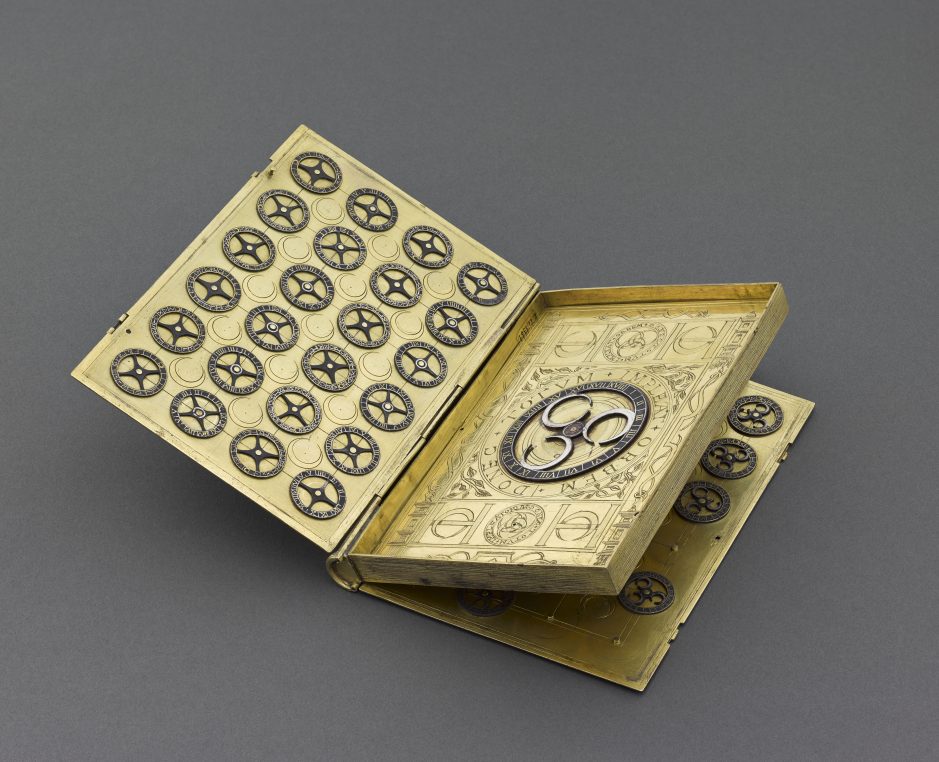
2 Comments on “In Ecouen, coats of arm speak up”
What beautiful artwork! Art and history. This “Connétable”, burdened as he was with a lady’s forename, was the most powerful person in the Kingdom after the King. Not someone to be trifled with.
Pas au courant de cette exposition à Écouen. Très intéressant thème couvrant tous les arts.